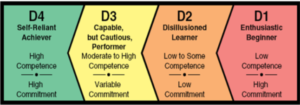
What is the difference between training, coaching and mentoring?
May 13, 2024
The pros and cons of hybrid working: A guide for modern leaders
July 10, 2024One size doesn’t fit all when it comes to leadership. It requires adaptability and a keen understanding of the individuals being led. One approach to this complexity is situational leadership, a model designed by Blanchard and Hersey to help leaders tailor their approach based on the developmental level of their team members.
And this approach really does work. A study examined the impact of situational leadership on job satisfaction and employee performance within small and medium-sized enterprises (SMEs). The findings revealed that this leadership style has a significant positive effect, contributing to a 50.9% increase in both job satisfaction and employee performance.
This blog explores situational leadership and the importance of getting it right.
Diagnosing developmental levels
At the core of situational leadership is diagnosing the developmental level of individuals within a team. This involves assessing their competence and commitment to a specific task or goal.
Developmental levels range from D1 to D4, with each level reflecting a unique combination of competence and commitment.
Adapting leadership styles
Much like our previous blog on the difference between training, coaching and mentoring and choosing which method is the most appropriate for the situation, effective leadership hinges on matching the appropriate leadership style to the developmental level of team members.
Situational leadership theory describes four distinct leadership styles based on varying combinations of directive (task-focused) and supportive (relationship-focused) behaviours.
1. Directing – Using high directive and low supportive behaviour. Leaders provide clear instructions, closely supervise tasks, and make decisions for the team. This approach is effective for inexperienced or new team members who require guidance and structure. However, if used with experienced or capable individuals, it can lead to micromanagement, reduced morale, and dependency.
2. Coaching – Using highly directive and highly supportive behaviour. Leaders provide guidance, support, and encouragement while still directing tasks. It is particularly beneficial for team members who are motivated but lack the necessary skills or confidence. Yet, overuse of coaching can result in a lack of autonomy and hinder the development of self-reliance in team members.
3. Supporting – Using low directive and high supportive behaviour. Leaders provide support, encouragement, and resources while giving team members more autonomy in decision-making. This is effective for competent team members who require less direction and benefit from a supportive environment. However, it may lead to confusion or inefficiency if team members are unclear about expectations or lack guidance.
4. Delegating – Using low directive and low supportive behaviour. Leaders use this approach to provide minimal direction and support, allowing team members to take responsibility for tasks and decisions. This style is effective for experienced, self-motivated team members who thrive with autonomy. Nevertheless, it can be ineffective if team members lack the skills, confidence, or motivation to work independently, resulting in errors or missed deadlines.
Using the wrong leadership style can lead to inefficiency, demotivation, stagnation, and conflict. To combat these, leaders must assess the competence and commitment levels of their team members and adapt their leadership style, providing the appropriate level of direction and support for each situation.
The dynamics of leadership preference
Leaders need to recognise that their preferred leadership style may not always align with the needs of their team members. A leader’s leaning towards empowerment or micromanagement must be balanced with the developmental level of individuals. What works for one team member may not be effective for another, emphasising the importance of flexibility and situational awareness.
Remember that team members can shift between developmental levels based on various factors such as experience, training, changing responsibilities, and personal motivations. For example, a team member who experiences a setback or loss of motivation may regress to lower developmental levels, requiring additional support and guidance from the leader to regain confidence and commitment.
Next steps
Do you need help matching your leadership style to the developmental level of team members? Cube Learning and Development delivers tailor-made training and development programmes for your teams along with personal coaching to help with effective communication and presentation. For a no-obligation chat about this and our other training, call Chris Burton on 07879 602002.





